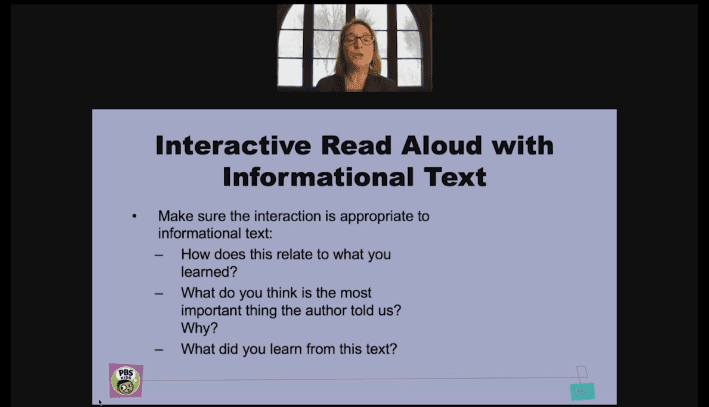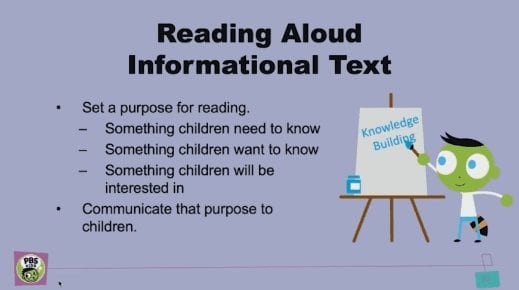Dos and Don’ts for Using Informational Texts with Young Learners
With the Common Core Standards came an increased focus on reading informational texts, starting with kindergarten. But integrating informational texts isn’t as simple as having students read a couple of biographies every marking period. In PBS TeacherLine’s edWebinar, “Strategies to Engage Young Learners with Informational Text,” Nell Duke, Professor of Literacy, Language, and Culture at the University of Michigan School of Education, offered her advice for understanding and incorporating informational texts in the classroom.
First, teachers should get familiar with informational texts, which are media where their primary purpose is to convey information, to understand how they can support classroom lessons. While non-fiction books are what most educators think of, informational texts can include audio, images, video, etc. It’s the purpose of the text that matters more than the medium used. Also, informational texts come in many varieties.
- Informative/Explanatory: conveys information about our world, like science and history texts
- Procedural/How-to: includes step-by-step instructions and can even be something like game directions
- Biographical: includes any media that focuses on a person’s life—doesn’t have to be traditional books about well-known individuals. For instance, students might read about local community members.
- Functional: helps students complete everyday tasks
- Non-fiction narrative: sharing and interpreting a true story
Next, before teachers use an informational text, they need to analyze the different structures of the media. Does it use graphs or charts to convey information? Does it have headings, subheads, or numbered steps to guide students? In other words, what elements does the text use that differentiate it from the fiction that students are more accustomed to? These will become teaching points with students.
When integrating informational texts into lessons, teachers need to keep a few things in mind.
- First, the texts need to be associated with overall lessons. They should be something the students need to do for school or that they want to know about.
- Then, communicate the purpose to the students. Help them understand why they are reading it and how they will use it with their unit.
- If reading it aloud, make sure to use expression just as if it were a fiction book. However, reading informational texts often requires frequent stopping to analyze what’s been said, look at images, or relate the information to the larger lesson. Often, they should be read over multiple days.
- Whether reading out loud or having students do it on their own, allow plenty of time for interaction. Have students work in small groups and talk to each other as well as the teacher.
- Give students prompts for their interaction, e.g., What do you think is the most important thing the author told us and why? Or what did you learn from the text? By providing prompts you can guide students toward purposeful reading.
- Finally, expose students to a variety of informational texts, even within the same unit. Use websites, pamphlets, books, and magazines together to give a broader perspective on a topic and to help students understand how to read different media.
Duke did highlight common pitfalls: one-time reading assignments, one-time writing prompts, assigning more extended reading but not connecting to lessons, or random, unplanned assignments. Overall, her advice is to audit curricula with informational texts in mind, figuring out where they can support learning goals and making sure that students are exposed to diverse sources.
This edWeb broadcast was sponsored by PBS TeacherLine.
This article was modified and published by eSchool News.
About the Presenter
Nell Duke, Professor of Literacy, Language, and Culture at the University of Michigan School of Education, focuses her work on early literacy development, particularly among children living in poverty. She has published widely, including her most recent book, Inside Information: Developing Powerful Readers and Writers of Informational Text through Project-based Instruction. Duke is co-editor of The Research-Informed Classroom book series and co-editor of the Not This, But That book series. She is the literacy consultant for the PBS KIDS television series Molly of Denali, a program designed to help kids ages 4-8 develop knowledge and skills for interacting with informational texts through video content, interactive games, and real-world activities.
Join the Community
Engaging Early Learners is a free professional learning community on edWeb.net that provides PreK to grade three educators and administrators with a place to collaborate on teaching and nurturing the young learners under their care.
PBS TeacherLine courses offer educators online, standards-based professional development opportunities that are tied directly to the curriculum and incorporate assignments and activities that can be used in the classroom right away. Expertly facilitated by instructors with years of experience and deep content knowledge, PBS TeacherLine courses are the perfect way to build your skills, enhance your knowledge and grow in your career.






Comments are closed.